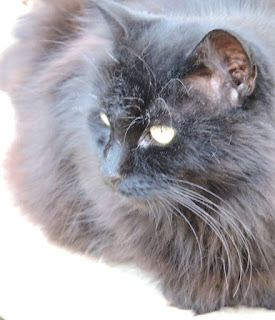 |
| Norman and Denzel - BC |
Many of the volunteers at the Sanctuary work in specific areas, and get to know the cats there really well, while not knowing cats in other areas. I do quite a lot of fill-in in the main complex, but somehow I rarely spend much time in New Aids and the Moore House. Following a shift last week, rather than sitting down with my usual cuddle-buddies, I decided it was time for a visit with the Aids cats.
 |
| Max and Tiberius - BC |
In part, this was prompted by plans for next year’s RAPS Cat Sanctuary Calendar. Two of the pictures we’ve selected are of cats from the New Aids pen, and though I was in on the selection, the photos had been taken by Michele. In fact, both are black cats – notoriously difficult to photograph – and though you’ll have to wait for the calendar to see the final beautiful pictures, this is a quick introduction to some of the personalities involved.
 |
| Norman - MW |
Claire introduced us to
Norman several years ago. He came to us through VOKRA – he was found as a stray and taken to Killarney Vet Hospital. When it turned out he was FIV-positive, and a little nippy, it proved more difficult to find him a home, and he was transferred to our care. He’s a handsome black panther of a boy, very friendly now, and ready to interact with humans; he’s a little more picky about his own space with other cats. Petting at the front end is encouraged; an old hind leg injury left him a little sensitive about rear-end touch.
 |
| Norman - MW |
It is worth noting again that, though communicable, the FIV virus is only transmitted through blood, i.e. cat-bites, and as such is more often seen in unneutered male cats. Once the cat is neutered and settled down, he can actually co-exist with Aids-negative cats quite happily, as long as the cats get along. The story of
Simba and Jack, a couple of years ago, was an example of a pair that didn’t want to be separated.
 |
| Denzel - MW |
If you’re sitting with Norman, the chances are that Denzel will be somewhere close. These two are not exactly buddies, but they both like human attention, and the chance of treats. Denzel is one of those cats whose black fur is flecked with white hairs, giving him a slightly grizzled appearance. He’s another “import”, coming from Keremeos.
 |
| Denzel - PH |
 |
| Tiberius - MW |
Tiberius is not a friendly cat – but there’s been a big improvement in his behaviour since he first came to us as an angry feral. He prefers to use one of the many shelters in the courtyard rather than enter the house, and because he was so unapproachable in his first years with us, he was frequently very matted, developing dreadlocks that had to be shaved off under sedation.
 |
| Tiberius - BC |
These days he is much more a part of the courtyard crowd, even entering the house on occasion, and he is no longer spooked by the sight of a human in his space. He’s ready to hover at treat-tossing distance, and risk another cat moving in on his prize. It takes a while, but we’ll bring him round...
 |
| Minew - MD |
This pretty girl is the second of the black cats to feature in the 2018 calendar. Minew is one of the smaller population of female Aids cats – Holland was introduced in an earlier blog – and has come to us from one of the shelters on Vancouver Island. I don’t know whether Minew’s name derives from “minou”, which is the French word for a little cat. Minew is still pretty shy, and seems to hang around Holland – two timid girls giving each other courage. She’s more ready to interact with humans than her older buddy, and is often happy to play with a string toy. You need to be careful when petting her – she’s one of those cats who is very particular about where she’s touched, and very quickly overstimulated by sensation. She’s so cute, it’s easy to forget about those teeth!
 |
| Minew - MD |
We’ve recently had more cats come into New Aids, transferred from other rescues. I can see that I need to spend more time here to make new friends and introduce them through the blog.
Pictures by Brigid Coult, Melanie Draper, Phaedra Hardman, Michele Wright














No comments:
Post a Comment